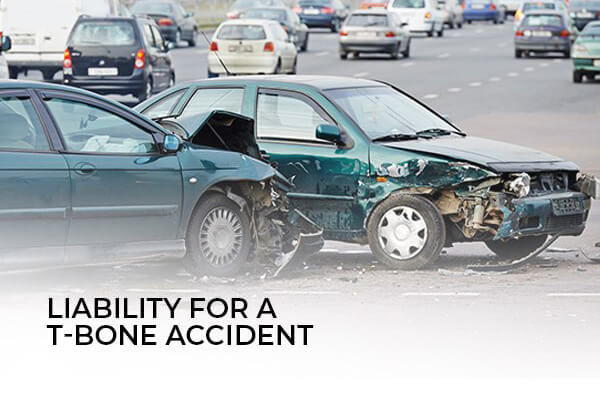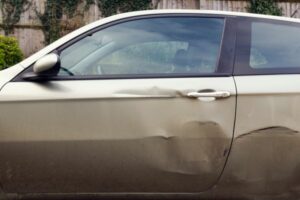
You are on your way to work, listening to your favorite song. As you come to an intersection, the stoplight turns yellow. Since you are close enough to the line, you decide to keep going forward. Suddenly, you feel a jolt and your car swerves—another vehicle has struck you from the side! Dazed, you realize you were involved in a T-Bone accident. A million thoughts cross your mind: how will you pay for the damages? How serious are your injuries? Who is liable for the accident? How can you claim compensation for the damage and injuries you’ve sustained? Will you be the one held responsible?
The dedicated car accident attorneys at the Hernandez Law Group, P.C. have helped countless car accident victims claim the compensation they deserve from the negligent party. In this article, our team takes a closer look at T-Bone accidents and how you can tell which party should be held responsible.
What Are T-Bone Accidents?
When one vehicle strikes the side of another, forming a T, a T-Bone accident has occurred. This kind of accident, also known as a side-impact collision, can result in serious life-threatening injuries and even wrongful death.
The main danger of these accidents is that, since most vehicles have less padding on the side of the car, occupants may feel the full impact of the collision, unlike during a head-on or rear-end accident. The only protection that the driver and passengers may have is a thin door with windows that are likely to shatter during the accident.
What Can Cause a T-Bone Accident?
As with most car accidents, T-Bones are often a result of the negligence of one or more parties involved in the accident. The following behaviors are among the most common causes of T-Bone accidents:
- Driving under the influence of drugs or alcohol
- Speeding
- Road rage
- Distracted driving
- Running a red light or stop sign
- Loss of control of the vehicle
What Kind of Injuries Often Result From a T-Bone Accident?
T-Bone accidents often result in serious injuries as most vehicles do not have the same protection on the side as they do on the front or back. Injuries often associated with T-Bone accidents include:
- Concussion
- Whiplash
- Spinal cord injuries
- Broken bones
- Paralysis
- Chronic pain
- Nerve damage
- PTSD or other mental illness caused by the trauma of the accident
Who Is Liable For a T-Bone Accident?
Depending on the circumstances leading up to the accident, one or both parties may be at fault in a T-Bone accident. Let’s look at the scenario painted at the beginning of this article to unpack how one or both drivers can be held liable.
One Driver Is Held Liable

T-Bone accidents only occur when one driver fails to give the right of way to another driver. Therefore, whichever driver wasn’t paying attention or breaks the law will typically be the person found at fault for the accident.
In the case of the scenario above, if driver one was close enough to the line to go safely through the intersection while the light was still yellow, they have the right of way. This means the second driver jumped the green light and caused the crash. They would be fully responsible for the accident.
However, let’s say driver one was turning left. If the left-turn light was blinking yellow, meaning they should yield to oncoming traffic, and they failed to stop or check traffic, causing the second driver to hit them, driver one is responsible.
Both Drivers Are Liable
Let’s say the intersection the drivers came to was a four-way stop indicated by stop signs. Both drivers have a duty and responsibility to pay attention as they come up to the intersection. If the first driver was distracted and failed to pay attention to the stop sign, striking the second driver who did stop but failed to notice the first driver still crossing, both may be held liable for the accident. It is the duty of both drivers to ensure that they and others can get through the intersection safely.
This rule of negligence is known as comparative negligence. The State of Texas follows the modified comparative negligence principle. This principle states that a plaintiff cannot recover damages if they are found to be more than 50% at fault for their accident. The deeming of liability for both parties lies with the judge or jury presiding over the case.
How Is Liability Shown For a T-Bone Accident?
Liability is shown through evidence supporting the negligence of one or both parties in the accident. Evidence can consist of:
- Official police report of the accident
- Witness statements
- Photographs of the accident site
- Photographs of the damage to the vehicles
- Photographs of injuries
- Medical records
- Personal statements from both drivers
Get the Compensation You Deserve For a T-Bone Accident
Getting a personal injury attorney enables you to gather the evidence necessary to prove the negligence of the other party and claim the compensation you deserve. The team at Hernandez Law Group, P.C. works tirelessly to ensure that all information is in order to show the judge and jury exactly what happened during the accident. Our dedicated and knowledgeable staff put our clients’ needs first, which is why we have a no-win, no-fee contract. Contact us today to get in touch with our attorneys, such as Juan Hernandez, one of the two percent of Texas Board certified personal injury attorneys. We are here to fight for you!
